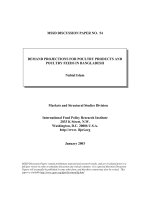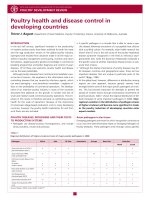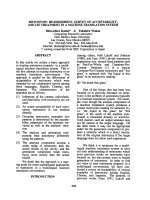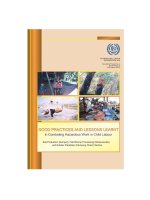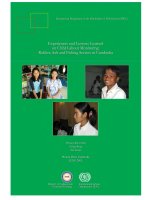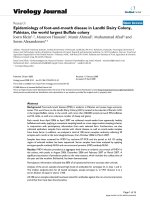Uterine endometrial regeneration and conception rate following oestrus induction with CIDR and ovsynch treatment in postpartum dairy cows
Bạn đang xem bản rút gọn của tài liệu. Xem và tải ngay bản đầy đủ của tài liệu tại đây (793.59 KB, 7 trang )
Int.J.Curr.Microbiol.App.Sci (2018) 7(3): 918-924
International Journal of Current Microbiology and Applied Sciences
ISSN: 2319-7706 Volume 7 Number 03 (2018)
Journal homepage:
Original Research Article
/>
Uterine Endometrial Regeneration and Conception Rate Following Oestrus
Induction with CIDR and Ovsynch Treatment in Postpartum Dairy Cows
C. Velladurai*, S. Alagar*, M. Selvaraju and R. Ezakial Napolean
Department of Veterinary Gynaecology and Obstetrics, Veterinary College and Research
Institute, Namakkal-2, Tamil Nadu, India
*Corresponding author
ABSTRACT
Keywords
Uterine
endometrium,
Conception rate,
CIDR, Ovsynch,
Cows, Postpartum
Article Info
Accepted:
10 February 2018
Available Online:
10 March 2018
Endometrial histopathology was studied in 16 postpartum dairy cows. Endometrial biopsy
was taken from the all experimental animals, to study the histopathological changes of the
uterine endometrium. 8 cows in group I (n=8) on day 2 postpartum and were treated with
an intramuscular injection of 5 mg methyl ergometrine maleate. All the cows in group I
were inserted with Controlled Internal Drug Release device (CIDR) on day 45-55
postpartum intra-vaginally. Whereas 8 cows in group II (n=8) were selected at day 35-50
postpartum and supplemented with TANUVAS mineral mixture and treated with ovsynch
treatment. In group I cows on day 10 postpartum, showed involution process, with mild
neutrophilic and mononuclear infiltration. When compared to day 10 postpartum, the
regenerative changes of epithelium and endometrial glandular activities were predominant
on day 30 postpartum. In group II cows before treatment (at the time of animal selection),
the uterine endometrium was intact. Multiple glandular acini and congestion were noticed.
Uterine subendometrium showed few glandular acini lined with single layer of epithelial
cells. After treatment (at AI), showed active proliferation of epithelial cells with intactness
of endometrium. Uterus showed normal architecture of subendometrium with glandular
acini. The intact endometrium with hyperplasia of endometrial glands was observed. The
first service, second service and overall conception rates observed were 22.22, 33.33 and
55.55 and 37.50, 50.00 and 87.50 per cent in Group I and II, respectively. Hence it is
concluded that increased conception rate after ovsynch treatment in postpartum cows
positively correlated with the well healthy endometrium lining and glandular development.
Introduction
The uterine endometrial biopsy technique was
more useful in evaluating the endometrial and
ovarian status in post-partum cows.
Microscopically, during postpartum period the
uterine lining epithelium was found to be
normal with pseudo-stratified columnar type.
Sub-epithelial diffuse haemorrhages, cellular
infiltration in uterine stroma and stromal
oedema were observed. Uterine glands were
found dilated and filled with desquamated
material.
Cytoplasmic
vacuolation
in
glandular epithelium and oedema of uterine
glands were observed (Morrow, 1980).
Uterine biopsy was a valuable diagnostic tool
in identifying morphological alterations in the
uterine endometrium (Prasad and Krishna,
918
Int.J.Curr.Microbiol.App.Sci (2018) 7(3): 918-924
2009). The endometrium of all mammals is
richly endowed with glands that open on to the
luminal surface. The endometrial glands
secrete a variety of molecules, collectively
termed as histotroph or uterine milk that is
essential for maternal support of conceptus
survival and growth in mammals (Gray et al.,
2001). Pathak and Bansal (2012) observed that
the endometrial glands were simple or
branched tubular glands of which few were
coiled distally. They were lined with simple
columnar epithelium. These glands were more
active during the follicular phase as compared
to the luteal phase of the oestrous cycle. But
the secretary activity was more pronounced
during the luteal phase. Raja et al., (2012)
reported that the histopathology of
endometrium showed marked cellular changes
of different degrees such as glandular
hyperplasia, degenerative changes of the
endometrium, cystic dilatation, mononuclear
infiltration and perivascular fibrosis. Hence,
the present investigation was formulated to
study the effect of ovsynch treatment and
CIDR on endometrial regeneration and
conception rate in postpartum dairy cows.
Materials and Methods
An experiment was conducted in postpartum
dairy cows which were selected from Large
Animal Gynaecology unit of Teaching
Veterinary Clinical Complex (TVCC),
Veterinary College and Research Institute,
Namakkal and from Veterinary Dispensaries,
Tamil Nadu Co-operative Milk Producer
Federation (TCMPF) Co-operative societies
which are located in and around Namakkal
district of Tamil Nadu for the study. Normally
calved 16 healthy cows aged between 2nd and
5th lactations were selected immediately. Day
of parturition was considered as day 0 of the
experiment. On day 2 postpartum, cows of
group I (n=8) were treated with an
intramuscular injection of 5 mg methyl
ergometrine maleate (5 ml, Utrasafe®, Vet
Mankind, New Delhi, India). All the cows in
group I were inserted with Controlled Internal
Drug Release device (CIDR, EAZI - BREED,
Pfizer Animal Health Ltd, India) (Plate 1) on
day 45-55 postpartum intra-vaginally and left
in situ for 9 days. All the cows had received
an intramuscular injection of 25 mg of PGF2α
(5 ml, Lutalyse®, Pfizer Animal Health Ltd,
India) 24 hours before the withdrawal of
CIDR and timed artificial insemination (TAI)
was done at 48 and 72 hours after PGF2α
injection. In group II cows were selected at
35-50 days postpartum. All the cows in group
II were supplemented orally with TANUVAS
mineral mixture daily @ 30-50 grams for 15
days. At the end of mineral mixture
supplementation cow were treated with
ovsynch protocol. The protocol included
administration of 10 µg of GnRH
intramuscularly (2.5 ml, Buserelin acetate,
Ovulanta®, Vet Mankind, New Delhi) on the
day of start of synchronization (day 0), 500 µg
of PGF2 intramuscularly (2 ml, Cloprostenol,
Pragma®, INTAS, Ahmedabad) seven days
later (day 7), another 10 µg of GnRH
intramuscularly 48 h after PGF2 (day 9) and
timed artificial insemination (TAI) was done
at 16 to 18 hours after the second GnRH
injection (day 10).
Endometrial biopsy was taken in group I cows
on (i) day10 and (ii) day 30 postpartum and in
group II cows (i) at the time of animal
selection (before treatment) and (ii) at AI
(after
treatment),
to
study
the
histopathological changes of the uterine
endometrium. Albuchin’s uterine biopsy
catheter (Plate 2a and 2b) was used to obtain
endometrial biopsy samples as per the
technique followed by Palanisamy (2012) with
slight modifications. The closed, sterilized
biopsy catheter was introduced into the uterus
adopting aseptic technique. The biopsy
catheter was advanced into one of the uterine
horns of uterus and the catheter was opened.
The uterine wall was pressed with the thumb
919
Int.J.Curr.Microbiol.App.Sci (2018) 7(3): 918-924
against the opening of the catheter. The
catheter was closed, rotated and retracted
slowly. Slight pressure was applied against
catheter to prevent haemorrhage before
retracting the instrument. A piece of
endometrium was released from the cutting
edge of the catheter into a vial containing
Bouin’s fluid and stored for 24 hours and
processed by routine paraffin technique and
stained with haematoxyline and eosin as per
technique described by Bancroft and Gamble
(2008).
In both the groups fixed time artificial
insemination done during the induced oestrus
with good quality frozen thawed semen. Those
animals which failed to conceive and returned
to oestrus, were again inseminated during the
subsequent oestrus. Conception rate was
calculated as percentage of animals that
conceived to AI at induced oestrus in both the
groups. Pregnancy was confirmed by rectal
palpation at 60 days post insemination.
Results and Discussion
The histopathology of uterine endometrium of
group I cows is presented in Plate 3, the
histopathology of uterine endometrium of
group II cows before treatment (at the time of
animal selection) is presented in Plate 4 and
the histopathology of uterine endometrium of
group II cows after treatment (at AI) is
presented in Plate 5.
Uterine biopsies are routinely used for
diagnosis of reproductive failures in human
gynaecology and are thought to be the gold
standard for endometrial evaluation in infertile
women (Strowitzki et al., 2006). In this study
in cows of the group I, on day 10 postpartum
uterine lining epithelium was found to be
normal with pseudostratified columnar type.
Endometrium showed involution process with
mild
neutrophilic
and
mononuclear
infiltration. The endometrial glandular activity
was seen in few cases with increased vascular
spaces. On day 30 postpartum there was an
increased endometrial glandular activity with
extensive lymphocytic infiltration.
These observations were in accordance with
the findings of Prasad and Krishna (2009) in
postpartum normally calved cows. In cows of
the group II, the endometrial lining and
glandular acini remained functional and
unchanged before and after treatment without
any degenerative changes or hyper plastic
changes and it was in accordance with the
findings of Singh et al., (1997) in buffaloes
and Prasad and Krishna (2009) in cows. These
endometrial involution and regenerative
changes clearly reflected on the conception
rate.
Plate.1 CIDR with Applicator
920
Int.J.Curr.Microbiol.App.Sci (2018) 7(3): 918-924
Plate.2a Albuchin’s uterine biopsy catheter-with closed cut edge
Plate.2b Albuchin’s uterine biopsy catheter-with open tissue grasper
Plate.3 Histopathology of uterine endometrium in group I cows
Day 30 postpartum
Day 10 postpartum
H&E 400x
921
Int.J.Curr.Microbiol.App.Sci (2018) 7(3): 918-924
Plate.4 Histopathology of uterine endometrium in group II cows - Before treatment
(At the time of animal Selection)
Normal uterus showing the intact
endometrium.
H&E 400x
Normal uterus showing multiple glandular
acini and congestion.
H&E 200x
Uterine subendometrium showing few
glandular acini lined with single layer of
epithelial cells. H&E 400x
Uterus showing a solitary glandular acini
lined by multi layers of epithelial cells.
H&E 400x
Plate.5 Histopathology of uterine endometrium in group II cows - After treatment (At AI)
Uterus showing the proliferation of epithelial
cells with intactness of endometrium.
H&E 400x
Uterus showing the active proliferation of
epithelial cells lining the glandular acini.
H&E 400x
922
Int.J.Curr.Microbiol.App.Sci (2018) 7(3): 918-924
Uterus showing hyperplasia of epithelial cells
lining endometrium.
H&E 1000x
Uterus showing normal architecture of
subendometrium with glandular acini.
H&E 400x
The first service, second service and overall
conception rates observed in this study were
22.22, 33.33 and 55.55 and 37.50, 50.00 and
87.50 per cent in group I and II, respectively.
In group I cows treated with methyl
ergometrine maleate on day 2 postpartum
followed by oestrus induction with CIDR plus
PGF2α on day 45-55 postpartum yielded
55.55 per cent overall conception rate. In this
group the conception rate was better but it
was lesser than group II. Ramoun et al.,
(2006) proved the enhancement of uterine
involution due to the prolonged ecbolic effect
of methyl ergometrine maleate in the uterus of
buffaloes. Methyl ergometrine maleate
produced firm, prolonged contraction of
uterus that lasts for 3-4 hours (Roberts, 1986)
by a gradual relaxation over a period of 1.5
hours (Drost, 1987). It indicated the uterine
ecbolic drugs caused rapid uterine involution
which leads to improvement in conception
rates in group I cows.
the commencement of ovsynch at appropriate
stage of the oestrous cycle which would have
induced preovulatory LH surge and ovulation
as described by Moreira et al., (2000). The
increasing trend in the conception rate from
the first service to that of the second service
could be attributed to the sensitization of the
brain receptors by progesterone and good
response to the ovarian estrogen from a large
Graafian follicle of >10 mm diameter
followed by ovulation and formation of
functional corpus luteum establishing
pregnancy.
References
Bancroft, J.D. and Gamble, M. (2008).
Theory and practice of histological
techniques.
6th
ed.,
Churchill
Livingston, Elsevier, Philadelphia.
Drost, M. (1987). Clinical uses of hormones.
In ‘Society for Theriogenology, Cow
Manual, pp.73-80.
Gray, C.A., Taylor, K.M., Ramsey, W.S.,
Hill, J.R., Bazer, F.W., Bartol, F.F. and
Spencer, T.E. (2001). Histomorphology
of the endometrial gland of buffalo.
Biol. Reprod., 64: 1608.
Oestrus induction with ovsynch protocol at
50-65 days postpartum in group II cows
yielded 87.50 per cent overall conception
rates. It was in concurrence with the findings
of Pursley et al., (1997). Greater conception
rate achieved in the present study was due to
923
Int.J.Curr.Microbiol.App.Sci (2018) 7(3): 918-924
Moreira, F., De la Sota, R.L., Diaz, T. and
Thatcher, W.W. (2000). Effect of day of
the estrous cycle at the initiation of a
timed artificial insemination protocol on
reproductive responses in dairy heifers.
J. Anim. Sci., 78: 1568-1576.
Morrow, D.A. (1980). Current therapy in
theriogenology.
W.B.
Saunders
Company Philadelphia, London. pp. 7279.
Palanisamy, M. (2012). Efficacy of
immunomodulators, lugol’s iodine and
prostaglandin F2α in the treatment of
post-partum endometritis in cows.
Ph.D., thesis submitted to Tamil Nadu
Veterinary and Animal Sciences
University, Chennai.
Pathak, D. and Bansal, N. 2012.
Histomorphology of the endometrial
gland of Buffalo. Indian Vet. J., 89: 2528.
Prasad, B.C. and Krishna, K.M. (2009). Effect
of RFM on histomorphology of uterine
endometrium in cross bred cows. Tamil
Nadu J. Vet. Anim. Sci., 5: 164-166.
Pursley, J.R., Kosorok, M.R. and Wiltbank,
M.C. (1997). Reproductive management
of lactating dairy cows using
synchronization of ovulation. J. Dairy
Sci., 80: 301-306.
Raja, S., Devanathan, T.G., Kulasekar, K.,
Pazhanivel, N. and Balachandran, C.
(2012). White side test and endometrial
biopsy for diagnosis of endometritis in
repeat breeding cows. Indian J. Anim.
Reprod., 33: 56-58.
Ramoun, A.A., Darweish, S.A., Abou, H.A.
EI-Ghait and El-Fattouh, S.M. (2006).
Effect of enhancement of uterine
involution and earlier initiation of postpartum cyclicity on the reproductive
performance of buffalo. Reprod. Fertil.
Dev., 18: 545–550.
Roberts, S.J. (1986). Veterinary Obstetrics
and Genital Diseases. 3rd Edn.
Singh, J., Pierson, R.A. and Adams, G.P.
(1997). Ultrasound images attributes of
the bovine corpous luteum: structural
and functional correlates. J. Reprod.
Fertil., 109: 35-44.
Strowitzki, T., Germeyer, A., Popovici, R.
and Wolff, M.V. (2006). The human
endometrium as a fetility- determining
factor. Hum. Reprod. Update, 12: 617630.
How to cite this article:
Velladurai, C., S. Alagar, M. Selvaraju and Ezakial Napolean, R. 2018. Uterine Endometrial
Regeneration and Conception Rate Following Oestrus Induction with CIDR and Ovsynch
Treatment in Postpartum Dairy Cows. Int.J.Curr.Microbiol.App.Sci. 7(03): 918-924.
doi: />
924

